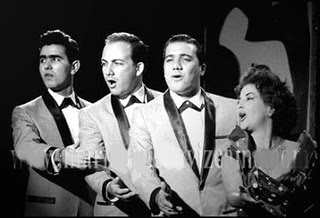11.15.1 The Modernists Quartet.

The Modernists, a Cuban vocal quartet founded in Havana in 1960, worked with Fernando Mulens. Gilberto Aldanás and Eugenio Fernández left the Carlos Faxas Quartet and joined Miguel de la Uz and Yolanda Brito.
Her first performance was on April 24 of that year, on a Channel 4 television program called “Show of Shows.”
Later, it was joined by Lourdes Torres, Gilberto Aldanás, Miguel de la Uz, and Eberto Rodríguez, who gained popularity during the late 1970s and 1980s for their work on radio and TV, as well as at numerous national events.
The quartet Los Modernistas occupied an important place in the vocal grouping of the Cuban capital’s nightlife.
In 1962, they performed the piece “A mi bandera” (To my flag), winning a prize at the Revolutionary Song Festival. In 1965, they performed Tania Castellanos’ song “Playa Azul” (Blue Beach), which won the Grand Prize and the performance award at the “First Varadero Song Festival.”
They demonstrated their work at the First Meeting of Protest Songs in 1967, with a song by Oscar Luis López entitled “Bajen y suban” (Get Down and Go Up), and won first prize for the theme song of the World Youth Festival, held in Berlin, written by Tony Taño.
When the First International Popular Song Festival of Varadero took place in 1967, they premiered two works by the then-unknown composer Silvio Rodríguez, becoming the first absolute interpreters of this now admired Cuban composer.
Los Modernistas’ first performance outside of Cuba took place in 1963, at the GANEFO sports competition held in Djakarta, Indonesia. However, their first tour as part of a major event took place in 1966, with performances in the USSR, Bulgaria, Romania, and Hungary, in theaters, public squares, workplaces, and on television.
They also participated in Expo 67 in Montreal, Canada. They toured again in 1971, which brought them back to the USSR, where they were declared, in a solemn ceremony, Honorary Members of the Central House of Art and Culture Workers of the USSR (equivalent to the National Union of Writers and Artists of Cuba).
They also repeated their performances in Hungary and Romania; and in 1980, audiences in Bogotá, Barranquilla, Medellín, Santa Marta, and Cali, Colombia, recognized and applauded them. They later appeared in Venezuela, appearing on the most important stages and television programs.
They traveled to Mexico City in 1981, and in the capital, they performed at the prestigious Teatro de la Ciudad, on Televisión Azteca, and in one of the three most important hotels. They returned to Mexico in 1988, performing in the states of Yucatán, Quintana Roo, and Campeche. In 1990, they visited Mérida again with a show directed by the renowned Tomás Morales, performing for three months at the Los Tulipanes nightclub.
His participation in multiple and important Song Festivals was unwavering in the quartet Los Modernistas.
In 1979, in the 2nd Adolfo Guzmán Cuban Music Competition, they received third prize with Lourdes Torres’s work “Un nuevo sentir me sorpresa” (A New Feeling Surprises Me), and in 1984 with “Abre tus alas canción” (Open Your Wings, Song). Another important competition was “Mi canto a la ciudad” (My Song to the City), where they performed Lourdes’s songs “Canción a mí Ciudad” (Song to My City). The following year, “Amazona Marina” won first prize in the aforementioned competition, all with editing, orchestration, and direction by maestro Tony Taño.
The quartet has performed in more than 20 major nightclub productions, some lasting more than a year. They have performed across the country, in theaters, plazas, bateyes, carnivals, cultural centers, camps, rural schools, and in the wilds of the Sierra Maestra and the Second Eastern Front.
The Los Modernistas quartet was present at the inauguration of satellite transmissions with the USSR, which coincided with the first broadcast of color TV. There wasn’t a single important moment in Cuban culture and art during that era when the Los Modernistas quartet wasn’t present. This vocal group undoubtedly inspired Cubans of the 60s, 70s, and 80s to enjoy and dream.








